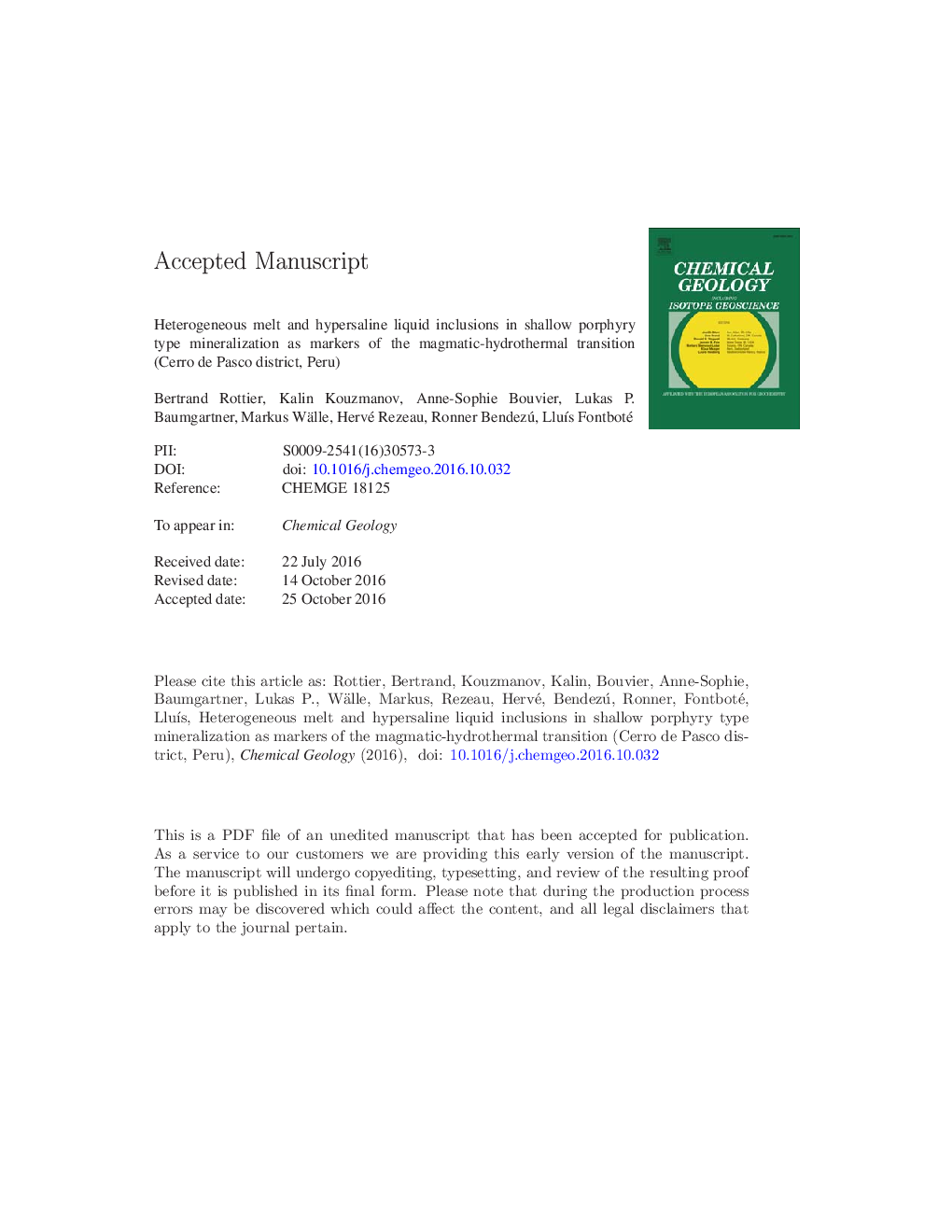| کد مقاله | کد نشریه | سال انتشار | مقاله انگلیسی | نسخه تمام متن |
|---|---|---|---|---|
| 5782984 | 1637527 | 2016 | 67 صفحه PDF | دانلود رایگان |
عنوان انگلیسی مقاله ISI
Heterogeneous melt and hypersaline liquid inclusions in shallow porphyry type mineralization as markers of the magmatic-hydrothermal transition (Cerro de Pasco district, Peru)
ترجمه فارسی عنوان
غلظتهای غیرمجاز مایع و هیپرزالیال مایع در کانی سازی نوع کم عمق پورفیری به عنوان نشانگرهای انتقال جرمی-هیدروترمال (منطقه سررو دپسکو، پرو)
دانلود مقاله + سفارش ترجمه
دانلود مقاله ISI انگلیسی
رایگان برای ایرانیان
کلمات کلیدی
موضوعات مرتبط
مهندسی و علوم پایه
علوم زمین و سیارات
ژئوشیمی و پترولوژی
چکیده انگلیسی
The banded porphyry-type veinlets record a multiphase history of formation with two successive high-temperature (> 600 °C) stages, followed by a lower-temperature (< 350 °C) stage. More than 90% of the quartz in veinlets precipitates during the first two high-temperature stages. Stage 1 is characterized by the entrapment in hydrothermal quartz of inclusions containing variable proportions of both silicate melt and metal-rich hypersaline (> 90 wt% NaCl eq.) liquid, hereafter referred to as heterogeneous silicate melt inclusions (HSMIs). The latter are rarely described in porphyry-type mineralization. We suggest that during stage 1, the inclusions result from heterogeneous entrapment of an evolved hydrous rhyolitic melt mixed with a hypersaline fluid phase at low pressure (270 bar) and high temperature (> 600 °C). The stage 2 is marked by the entrapment of metal- and sulfur-rich hypersaline liquid inclusions, with salinity around 70 wt% NaCl eq., originated from the adiabatic ascent of magmatic hypersaline fluids transferred from deeper parts of the system. The lower-temperature stage 3 is characterized by an important temperature drop from > 600 °C to < 350 °C as revealed by microthermometry of aqueous two-phase liquid-vapor (L-V) inclusions. Quartz textures revealed by SEM-CL imaging allow ascribing the sulfide precipitation to the low-temperature mineralization stage 3. In-situ SIMS 18O/16O isotope analyses of quartz across the veinlets are indicative of a magmatic signature of the fluids during the first two stages; while quartz from stage 3 has oxygen isotopic compositions suggestive of minor contribution of meteoric waters to a predominantly magmatic aqueous fluid (~ 10 vol.% of meteoric input), which probably triggered Cu-Fe sulfide precipitation in the stockwork. High metal and sulfur contents of HSMIs and hypersaline liquid inclusions determined by LA-ICP-MS are interpreted to represent the fluid composition prior to the main sulfide precipitation event. The similar Pb-Zn ratio of the bulk ore extracted from the epithermal ore bodies at Cerro de Pasco and the HSMIs and hypersaline liquid inclusions suggest a common source of the fluids associated with the different mineralization styles at Cerro de Pasco.
ناشر
Database: Elsevier - ScienceDirect (ساینس دایرکت)
Journal: Chemical Geology - Volume 447, 30 December 2016, Pages 93-116
Journal: Chemical Geology - Volume 447, 30 December 2016, Pages 93-116
نویسندگان
Bertrand Rottier, Kalin Kouzmanov, Anne-Sophie Bouvier, Lukas P. Baumgartner, Markus Wälle, Hervé Rezeau, Ronner Bendezú, LluÃs Fontboté,
